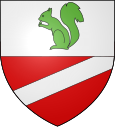Figanières
| Figanières | ||
|---|---|---|

|
|
|
| region | Provence-Alpes-Cote d'Azur | |
| Department | Var | |
| Arrondissement | Draguignan | |
| Canton | Flayosc | |
| Community association | Dracénoise | |
| Coordinates | 43 ° 34 ′ N , 6 ° 30 ′ E | |
| height | 227-719 m | |
| surface | 28.17 km 2 | |
| Residents | 2,605 (January 1, 2017) | |
| Population density | 92 inhabitants / km 2 | |
| Post Code | 83830 | |
| INSEE code | 83056 | |
| Website | http://www.figanieres.com/ | |
 Upper village with Saint-Michel church |
||
Figanières is a French commune with 2,605 inhabitants (at January 1, 2017) in the department of Var in the region Provence-Alpes-Cote d'Azur . It belongs to the canton of Flayosc in the Arrondissement of Draguignan .
geography
Figanières lies in a landscape characterized by wooded hills with wide valleys. The Cabre d'Or , La Clue , Saint-Val and Panisse forests surround the town .
history
Archaeological finds document the prehistoric and ancient settlement of the area. The Cabre d'Or dolmen date back to the Neolithic Age, and there were Gallo-Roman villages near Saint-Pons , Salettes and Buyedoux . The Via Julia Augusta crossed Salettes .
In the 11th century, the name of today's place appears as Figanera or Figanigra for the first time in the sources around 1200 as Figanerie . The place was under the rule of the Counts of Marseilles and later until the 17th century under that of the Lords of Ventimiglia . The castle was destroyed in the 16th century.
Population development
At the beginning of the 1960s, Figanières was a municipality with fewer than 500 inhabitants. Due to an above-average increase in immigration, the population increased in some cases rapidly by the end of the millennium, despite an average negative birth balance , and exceeded the 2000 inhabitant mark.
| year | 1962 | 1968 | 1975 | 1982 | 1990 | 1999 | 2007 | 2016 |
| Residents | 481 | 571 | 758 | 1176 | 1634 | 2230 | 2492 | 2602 |
| Sources: Cassini and INSEE | ||||||||
Culture and sights
The picturesque medieval village with narrow streets and old fountains is located on a hill around the parish church of Saint-Michel , which overlooks the town with its square tower. From the medieval castle of the Lords of Ventimiglia there are still ruins and a gate of the fortress wall.
The Notre-Dame-de-l'Olivier votive chapel was built in the 12th century. It is owned by the municipality. Since 1946 it has been a listed building as Inscrit Monument Historique .
Personalities
- Bertrand de Romans (around 1515–1579), Bishop of Fréjus, born in Figanières
